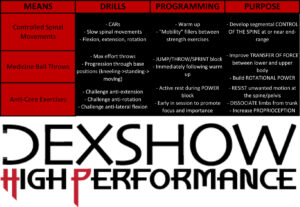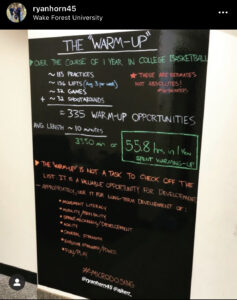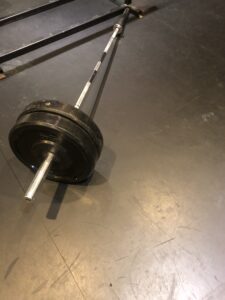Often times in Strength and Conditioning, especially in youth, we see athletes dedicate themselves to a certain sport during its respective season and focus solely on that. I’m a big advocate for playing multiple sports during adolescence for as long as possible until the athlete is “forced” to specialize. That topic is a subject for another post but what I’m getting at here is that ONLY playing your sport is not enough to get better at it, stay healthy playing it, or to become a well-rounded athlete. I’ll argue that strength training for sport is almost as important as playing the sport itself when the goal is performance, enjoyment, longevity, and remaining injury-free. This concept is exponentially more important for youth as their developing bodies adapt to stimuli fast and their base of muscle mass, strength, and resiliency is being built daily based on their activities. Here are 4 reasons why training away from your sport matters during the season:
- Well programmed strength training can help to diminish risk of overuse injuries and “undo” repetitive pattern adaptations. Humans are very adaptive beings. We are what we do, and our bodies respond by making the things we consistently do easier. The biggest example of this in modern life is sitting – we sit to eat, sit to drive, sit to work, sit to watch TV. Our bodies adjust and get very good at sitting, but if we don’t do anything else to counter this adaptation, our bodies won’t be ready for anything but sitting. That’s why your back hurts after going for a run for the first time in 6 months. The same goes for athletes playing a sport, especially developing youth. The more the athlete plays his or her sport, the more developed the musculature needed becomes and the bigger the strength gap gets between unused musculature and their “sport-specific” musculature. That’s a recipe for disaster, read INJURY. Great in-season strength training addresses the needs of the athlete to help mitigate imbalances in muscle/pattern usage but also helps to develop overarching strength, resiliency, and robustness, leading to our next point:
- In-season strength training will, at the very least, allow athletes to MAINTAIN their current level of strength and resiliency, and hopefully INCREASE it. We hear parents of athletes or athletes themselves say, “I want (my kid) to get faster/quicker/stronger,” but what does that entail? Well, according to strength and conditioning legend and pioneer Mike Boyle, it means at the most basic level, “don’t do the opposite.” If you want to get faster, don’t get slower. Need to be stronger? Don’t get weaker. In-season training prevents the drop off. I’m big on trying to utilize the most bang for buck, or low hanging fruit, and that means doing the least amount possible for the most results. If you or your child works hard and trains 2-3x per week in the off-season, don’t let it go to waste by not maintaining that hard work by training in-season. For kids, a single, consistent training session every week can keep them strong enough to perform and help to limit their potential for injury. I had a 12 year-old hockey goalie – who suffered from groin strains every season – start training with me once per week. He was my first client, and my most consistent. I saw him every week throughout his off-season and then through his hockey season and it was the first time he’d ever been through a season without an injury. In-season college and pro athletes lift 2-3x per week depending on their schedule – I’ve been there, I’ve done it. It’s needed, not just for older athletes, but for youth who are already physically under-prepared for the demands of their sport. Ensuring in-season training sessions is a priority and leads me to the next concept:
- Strength training in-season can help boost performance in sport. Surprise! That’s one of the main reasons we train in the first place. Besides performance enhancement, well designed training programs help to manage injury risk while keeping athletes resilient in all planes of motion – a quality desperately needed by EVERYONE. Training consistently throughout any given year starts to add up and the athlete’s base of strength, stability, power, speed, and mobility continues to grow cumulatively, so much so that:
- In-season training leads to a better off-season starting point which, in turn, leads to bigger, more consistent progress year after year. Building strength and resiliency is always a long-term process – it has to be. Intermittent or inconsistent training periods lead to short-lived adaptations and undulating levels of strength and conditioning. Building off of number 2, athletes training in-season can, at the very least, maintain their level of strength so that when the season is over and off-season training begins, they can pick up where they left off. If I send an athlete into his/her season and they come back next off-season having lost 20% of their gains from the last off-season, our time to actually get stronger is shortened. We have to regain the baseline strength that was lost over the course of the season first, and then work to get better from there. If the off-season phase was 12 weeks long, for instance, now 4 weeks are spent trying to regain training losses leaving only 8 weeks for improvements; whereas the athlete who trained in-season and maintained his/her baseline has the full 12 week off-season training cycle to drive positive adaptations. Don’t get in the habit of showing up to training camp or the start of every season at the same level of strength and conditioning. Your performance will suffer and much of your potential will be diminished.
As you can see, well-designed and correctly implemented strength training in-season is a necessity for athletes of all ages and levels. The benefits go far beyond improved performance and I’d argue that the limited amount of time required is well worth the trade offs of increased strength, resiliency, and robustness athletes can achieve with in-season training. There’s no better time than NOW start training intelligently.
Get strong, stay strong.
Coach Dex



